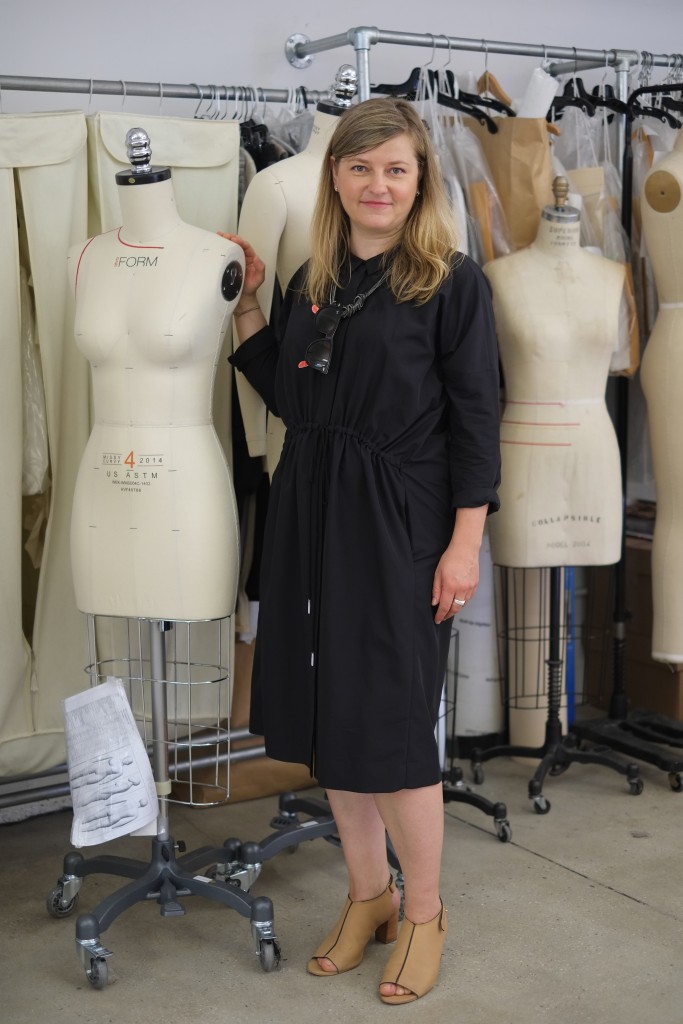“Werkstatt” roughly translates into work place from the German language, which makes perfect sense for Tina Schenk, the German-born CEO of the garment pattern development studio.
Based out of New York City’s Garment District, Werkstatt focuses on “creative, intelligent and well-constructed garment development,” as Schenk’s bio puts it, for fashion houses from Jason Wu to Maiyet, Alexander Wang, Helmut Lang, rag & bone, and Coach.
Schenk founded Werkstatt in 2008 with an impressive resume. After studying patternmaking and men’s custom tailoring in her native country and apprenticing for a tailor there, she relocated to Chicago in the early 1990s where she studied costume design.
She established the atelier of Helmut Lang where she was Chef d’Atelier and was VP of Technical Design and Head Atelier for Karl Lagerfeld before overseeing those of Calvin Klein Collection and Isabel Toledo for Anne Klein. In 2013, Werkstatt was a recipient of the inaugural CFDA Fashion Manufacturing Initiative (FMI) Grant Program.
Here, Schenk talks to CFDA.com about how she ended up in garment development, the industry’s needs today, and what it’s like to work with designers.
CFDA.com: How did you get into apparel manufacturing? What appealed to you about it?
Tina Schenk: “My company does product development, so we build the bridge between design and manufacturing. When I started my business, I had the background and experience in both of these areas, and development was the perfect place for me to apply the combination of my visual and technical skills.
I got my start in men’s custom tailoring and during my early years also worked as a cutter at a factory that manufactured high end women’s clothing. After studying design I transitioned to running the ateliers of several designers. It was during this time that I started to realize the importance of fully understanding a designer’s vision in order to successfully translate their sketches and ideas into final garments.
Nearly every designer I worked with also utilized outside help — local patternmakers and sample makers who could help develop the collection — yet at that time it was nearly impossible to find a pattern service that could seamlessly translate the designers’ intentions. Hence I decided to start my own: Werkstatt.”
CFDA.com: In what ways do you see patternmaking evolving? How do you integrate new technology with traditional techniques and how challenging is it to combine the two?
T.S.: “Up until last year, we exclusively made our patterns using traditional methods: draping and hand drafting. Receiving the CFDA FMI grant enabled us to switch the entire studio to a CAD system (Optitex) and we are now using the combination of all three methods. While CAD technology isn’t new, it is continuously evolving and becoming ever more user friendly. It took only three weeks to train my team and switch to the new system, which has enabled us work so much more efficiently.
Through this grant, we also received a series of Alvanon dress forms, which are based on 3-D body scans of actual people. These dress forms are much more accurate in terms of posture and proportions than any dress forms made using traditional methods. This, in turn, has enabled us to get an accurate fit much sooner in the development process, again saving time and resources.
I am excited about 3-D printing technology and am curious to see how it will change the way we develop garments.”
CFDA.com: Where do you see the most need within fashion production in New York City today?
T.S.: “I think the biggest challenge is still a lack in training for workers in the manufacturing sector. There has been a move towards high-end manufacturing, yet many of us struggle to find workers that are skilled to do the job. On the other hand, the type of training that is available doesn’t always offer a career path to the workers, so there is not much incentive for younger people to enter the field, as many of them see it as a dead end. I think serious thought needs to be given to establishing an apprenticeship program that can fulfill the needs of both, the manufacturer and their employees.”
CFDA.com: What do you consider the top three benefits of making clothes here?
T.S.: “There are definite advantages for New York designers to make their clothes here. The most important ones are ease of communication and collaboration, low manufacturing minimums and faster turnaround times, which not only benefit more established brands, but also make it possible for new designers to get their brands off the ground.”
CFDA.com: In your experience, what are the best and the worst things about working with designers?
T.S.: “I love working with designers and feel privileged to take part in the creative process of so many of them. The cyclical nature of the business can be a challenge, as it means long and intense working hours preceding fashion week, followed by a lack of work right after. However, working with many different companies also means working on many different calendars, which helps in equalizing the ebb and flow at least a little.”
CFDA.com: Where do see New York City apparel manufacturing in five years?
T.S.: “In the past few years there has been a move towards higher quality manufacturing and I think that trend is going to continue.
One of the things that will change is where the manufacturing is done. Due to recent major rent increases, many of us will have to move out of Manhattan within the next five years. Ultimately that’s going to change the way in which we collaborate with each other. How that’s going to affect the industry as a whole remains to be seen.”



